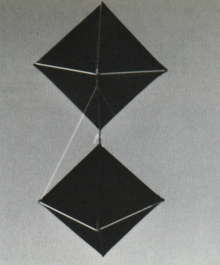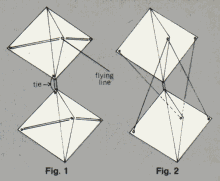Design WorkshopThe Rogallo Corner Kiteby Ed Grauel
Actually the Corner Kite is a two-cell box kite with four rigid side vanes emanating from the center of the kite rather than formed into squares -- in other words, a cross (+) rather than a box. Interestingly, the kite is easier to construct than the customary box and requires only four pieces of material 23 inches square. Plastic or Tyvek® can be used, but lightweight ripstop nylon is recommended because it permits firmer sleeves for the mast and spreader sticks. Avoid mixing different materials for the cover or the two cells because variation in porosity will result in poor flying performance. MATERIALS
TOOLS
INSTRUCTIONS1. Mark a 1" wide sleeve diagonally on each of the 4 fabric cover sections 2. Join the 2 cover sections together by placing one on top of the second so the diagonals are aligned and sew 2 rows of stitching, forming a diagonal channel or sleeve, which will form the center of the 4 vanes of the cell and receive the central mast. 3. Repeat the same sewing procedure for the remaining 2 cover sections. 4. Sew pockets or attach grommets to the vane tips. To explain: The corners of the vanes must be extended to build this kite. Rogallo uses neat cloth pockets for this purpose. I have found that the grommet-curtain hook system is easier to make and use. I put grommets in the vane tips which accept the spreader sticks fitted with curtain hooks. If pockets are used, they must be placed on each side of each of the open corners, making 8 pockets for each cell, or 16 pockets for the 2 cells. If grommets are used, only one per corner is required since the hooks can go into one eyelet from both sides. 5. Insert the center mast. To explain: The center mast which connects the two cells is 67" long. I use two 3/8" dia. dowels, each 33 1/2" long, which slip into a piece of brass tubing 4" long, and which acts as a connector at the center of the kite. Insert the center mast into the open ends of the diagonal sleeves on each cell. I drill a hole in each of the mast sections near the open ends of the sleeves and by means of needle and thread tie the cells to the mast to keep the cover sections from slipping up the mast. Rogallo puts eyelets near the inner ends of each open sleeve and ties the two cells together in the center with cord (see Figure 1). 6. Insert 8 spreader sticks 1/4" dia. x 23"
long into the small side pockets, or the grommets as the case may be, to
open 7. Now tie the supporting guy lines diagonally from vane tip to vane tip and repeat this process in the opposite direction on the other side of the kite (see Figure 2). The guy lines should be tied snugly, but not made so tight as to distort the configuration of the cells. 8. The flying line goes directly to any one of the 8 grommets holding the spreaders, omitting the necessity for a bridle. FLYINGYour Corner Kite should now be ready for airing. If it has been made carefully and the two cells are in good alignment and the center mast straight, it should take off from your hand in an 8 mile-per-hour wind and fly steadily and reliably as long as the wind stays under 20 to 22 miles per hour. If you want to attach a 14" drogue at the bottom of the center mast, the kite should take a maximum wind of 30 miles per hour. VARIATIONSI hear the question arising -- what about a single-cell Corner? This version will fly very well if bridled differently. While the double-cell Corner Kite flies on the principle of a box kite flown flat to the wind, the single-cell Corner flies on the principle of a box angled to the wind. To fly the single-cell version, use a two-leg bridle attached to the top and bottom of the center mast, just long enough to clear the spreaders, but not long enough to slip outside the vane tips on either side. An equal-sided three-point bridle attached at the top of the two adjacent horizontal corners could also be used. In my tests, the single-cell Corner had a wind range of 7 to 20 miles per hour using a 14-inch drogue, and attained an unusual angle of elevation of 60 degrees. From the Spring 1979 Kite Lines, © 1979 Æolus Press, Inc. Kite Lines Online is a
service of Quicksites Webstudio / Mike Gillard Communications and Kite
Lines magazine. All Rights Reserved. Contact
Us for advertising information. |
 If
you have been searching for a kite to make that is quite novel in
appearance yet flies well, this may be it -- the Corner Kite. Francis
Rogallo invented this kite for use as a radar reflector, and then
allowed it to gather dust in the Patent Office until his family's
enterprise, Rogallo Flexikites, started producing it commercially. Kite
buffs may obtain an original for $30 from Rogallo Flexikites, Kitty
Hawk, NC 27949. Or if you wish to make your own, Kite Lines is
privileged to present the instructions, with "Rog's" kind
consent.
If
you have been searching for a kite to make that is quite novel in
appearance yet flies well, this may be it -- the Corner Kite. Francis
Rogallo invented this kite for use as a radar reflector, and then
allowed it to gather dust in the Patent Office until his family's
enterprise, Rogallo Flexikites, started producing it commercially. Kite
buffs may obtain an original for $30 from Rogallo Flexikites, Kitty
Hawk, NC 27949. Or if you wish to make your own, Kite Lines is
privileged to present the instructions, with "Rog's" kind
consent.